|
|
Post by nuuumannn on Sept 14, 2014 23:58:51 GMT 12
Hi KB, neither. I live north west of Nelson on the Mainland. You could throw it over on your way in to Wellington  Although I will be in Auckland on the 28th of this month, at Ardmore to be exact. So, if you are going to be at the do Dave's organising, I might see you there? It looks to be a very captivating read; the intro on this link describes the story as fast paced, which, from the research I've been doing, which won't be as extensive or as in-depth as Dolan's, is certainly the case; lots of great little stories and events that took place. Take a look here: panmacmillanaustralia.wordpress.com/2013/09/05/gallipoli-air-war-by-hugh-dolan-extract/ |
|
|
|
Post by nuuumannn on Nov 4, 2014 18:43:38 GMT 12
The first part of my article on the aerial aspect of the Dardanelles campaign has been published in the November issue of New Zealand Aviation News. Here are a couple of images from the article I thought I'd share with you. A Short 166 suspended from Ark Royal’s crane, thought to have been taken in Kephalo Bay, Imbros during the Dardanelles campaign. A stalwart of the spotting operations from the carrier in the campaign, the Short 166 was also operated aboard the monitor HMS Roberts. Seaplane operations were fraught with difficulty, which included frequent equipment failure and a need for constant maintenance.  Credit National Museums of Scotland. The seaplane tender Ark Royal during trials in late 1914. A Sopwith 807 can be seen in its hangar below the bridge. Although seaplane tender operations were a success, the ship was slow and was vulnerable to submarine attack, which prompted her placement as a depot ship out of harm’s way at Kephalo Bay, then Mudros during the latter part of the campaign. 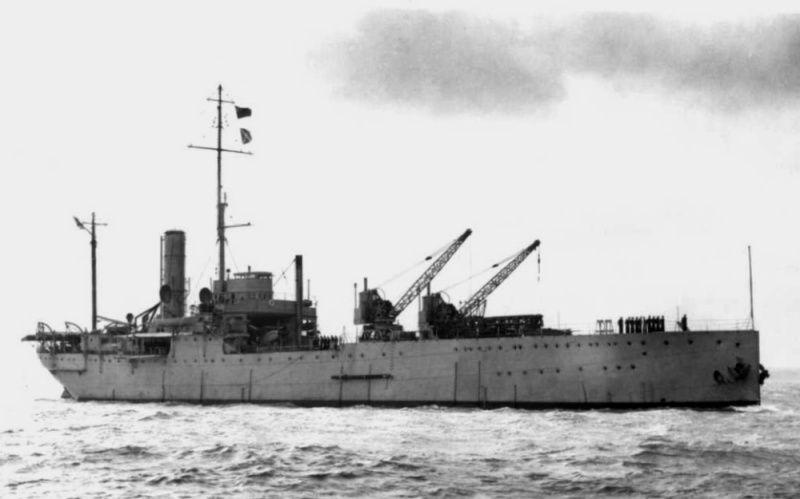 Credit Author's Collection. Taken at the end of the campaign in December 1915, the Duncan Class battleship HMS Cornwallis bombards Turkish shore positions in support of the Allied withdrawal, in Suvla Bay. Cornwallis was the last ship to leave after the withdrawal. At the commencement of the campaign, Cornwallis was ordered to cease firing as her gunnery was wildly inaccurate; her gun layers’ refusal to acknowledge the signals being sent to them by spotter aircraft did not help matters. 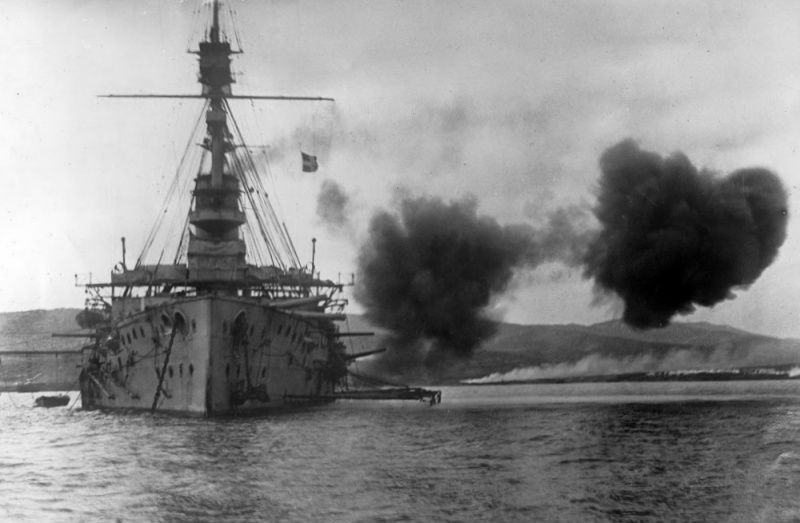 Credit Wikipedia. A B.E.2c of No.3 Sqn, RNAS takes off from the airstrip at Kephalo Bay, Imbros, possibly to escort the Submarine Scout (or Sea Scout) Class non rigid S.S.7 already airborne. Although sent to the region for anti-submarine patrols it was often employed for gunnery spotting and almost always flew with a aeroplane escort. On one operation, the airship was pursued by one of the few Turkish aeroplanes operating in the campaign, although nothing came of the 'attack'. 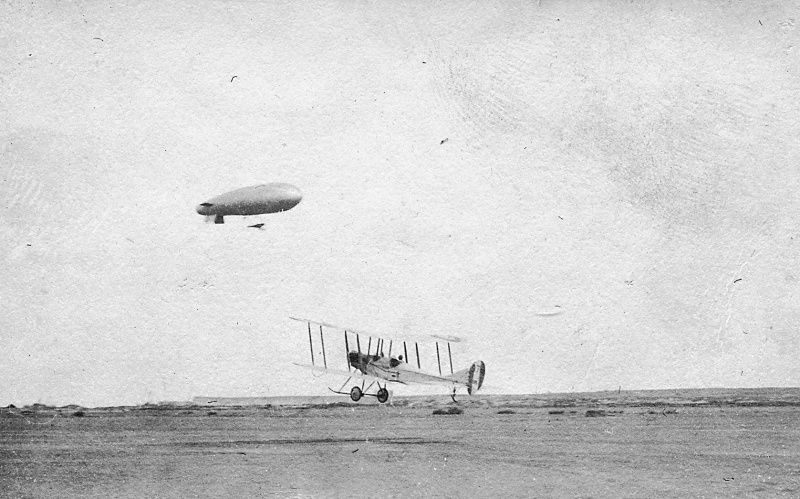 Credit via Philip Jarret. More images to come with the publishing of Part Two. |
|
|
|
Post by nuuumannn on Dec 8, 2014 17:49:58 GMT 12
More photographs of the Dardanelles campaign. The second part of my article has been published in the December/January issue of New Zealand Aviation News. One of four Avro 504Bs sent to No.3 Wing at Imbros in late August 1915, 1043 carried out reconnaissance and bombing raids against Turkish positions. Because of the warm climate and the effect it had on the aircraft’s engines, the Avros were flown as single seaters. Note the bomb racks below its wings and the Avro logo prominently displayed on its cowl.  Credit via Philip Jarrett. Two views of the same Henry Farman H.F.20 having suffered an unspecified incident, but was most likely repaired and returned to service. Note the red ringed and white centred roundels adopted by the RNAS at this time. Plagued with engine trouble and an inability to operate on hot days, the H.F.20s were considered next to useless and were eventually replaced by the far more capable Henry Farman F.27.   Credit via Philip Jarrett. A view of facilities at Imbros airfield with the fleet moored in Kephalo Bay in the distance. Two Bessonneau hangars and aircraft crates are visible; the aeroplane in the foreground looks to be undergoing assembly. The other two are Voisin III.LA pushers. Conditions were rudimentary at both Imbros and Tenedos airfields, where aircraft shipping crates were converted into personnel accommodation and workshops.  Credit via Philip Jarrett. Occupying a position almost directly opposite the strait from the town of Chanak, Çanakkale today, the Namazgah Fort and Kilitbahir Castle, with its distinctive three lobed design stand prominently in this aerial image taken after a shelling raid by the Allied fleet. This site was the principal objective of the British troop landings at Cape Helles on 25 April. Both can be visited today by catching a ferry from Çanakkale and are promoted by the Çanakkale tourist bureau as historic sites. 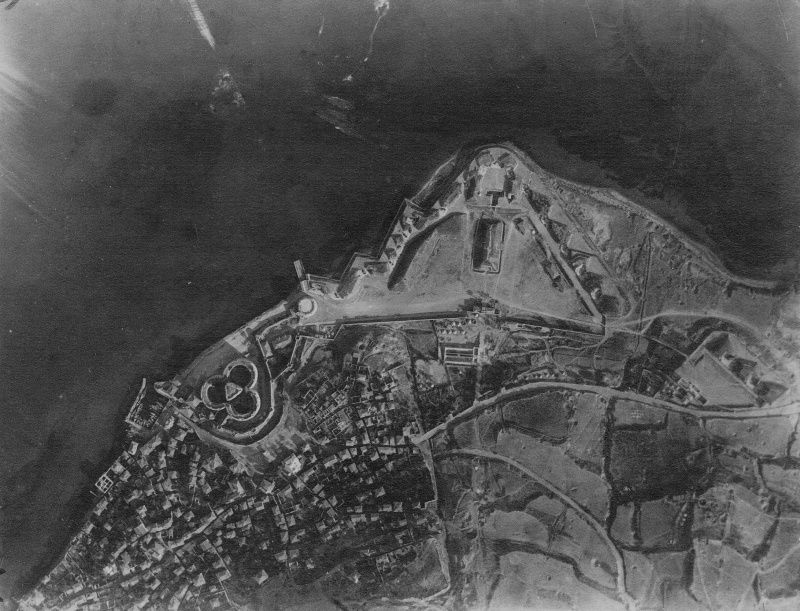 Credit Trevor Lee Collection. |
|
|
|
Post by davidsbremner on Jan 12, 2016 22:52:50 GMT 12
This is a fascinating thread, and I wish you well with the article. If I can be of any assistance, please let me know as I have a number of photos of my grandfather's. He was a pilot with No. 2 Wing at Imbros, and later at Thasos. We have built (and fly) a fully accurate reproduction of his favourite aircraft, Bristo Scout 1264. My blog is at www.bristolscout.wordpress.com |
|
|
|
Post by nuuumannn on Jan 13, 2016 15:50:22 GMT 12
Hello David, the articles have been published last year and I have also given presentations based on them to a couple of branches of the RAeS here in NZ. I have come across your aircraft in the past and have an image of 1264 in my presentation and which was published in support of a piece on your aircraft as a news feature in the magazine I write for. Here is the picture with 1264 in it. The image is grainy and is scanned from an original album, which is not in my possession. The caption is what I placed in my presentation:  Taken at Imbros in September 1915, men of 2 Wing RNAS inspect two of the recently arrived Bristol Scout Cs. 1264, behind the foreground machine, was lost when the ship on which it was being transported from Malta after maintenance was sunk en route to the island of Thasos a year later. In my presentation I expand on the caption and mention your project! In this close-up you can just make out the serial, which is clearer on the large size I received the images in. 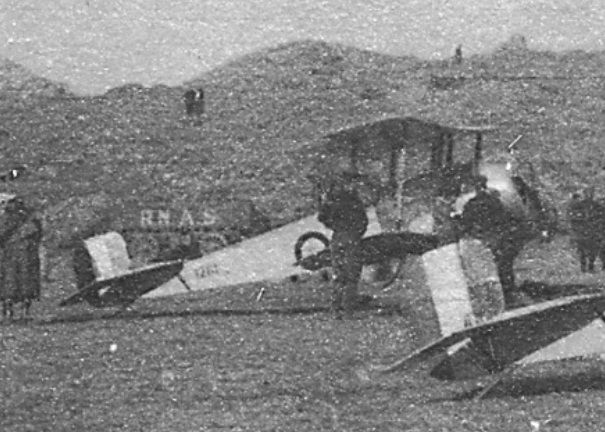 Good luck with your project. |
|
|
|
Post by Dave Homewood on Mar 23, 2016 16:53:02 GMT 12
You might like this Grant, from 4 April 1918  BRITISH NAVAL AIRCRAFT ATTACKING THE GERMAN BATTLE-CRUISER GOEBEN, AT THE ENTRANCE TO THE DARDANELLES Sir George Grey Special Collections, Auckland Libraries, AWNS-19180404-33-1 |
|
|
|
Post by Dave Homewood on Dec 12, 2018 10:09:29 GMT 12
|
|
|
|
Post by nuuumannn on Aug 8, 2020 14:58:48 GMT 12
You might like this Grant, from 4 April 1918  BRITISH NAVAL AIRCRAFT ATTACKING THE GERMAN BATTLE-CRUISER GOEBEN, AT THE ENTRANCE TO THE DARDANELLES Sir George Grey Special Collections, Auckland Libraries, AWNS-19180404-33-1 Thanks for those, Dave, the first picture is a stylised account of an attack on the Goeben, nominally in Turkish hands as the Yavus Sultan Selim, but still crewed by High Seas Fleet personnel under the Turkish flag, which took place from 20 January 1918 after the ship ran aground. Over six days the ship was harrassed by British aircraft, which flew more than 200 sorties against it, dropping 180 bombs. During the attacks, only two bombs are reported to have struck the ship. In 1917, for his troubles after being a vocal advocate for torpedo aircraft within the admiralty, Cdre Murry Sueter was sent to Otranto in the Toe of Italy with a squadron of Short 320 seaplane torpedo droppers with the aim of sinking the Goeben. Those aircraft in the illustration look like the Short 320s that were in the region, a more powerful replacement for the Short 184 torpedo aircraft that was used in the Dardanelles. Sadly, the Dan Snow link you provided is no longer valid; it would have been interesting if he added anything new to the story. |
|

